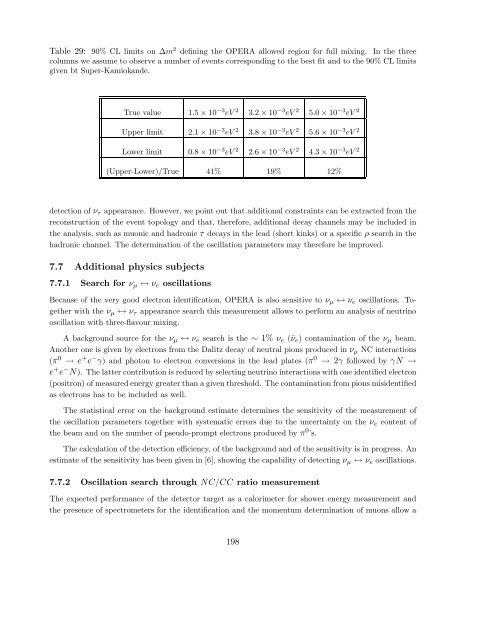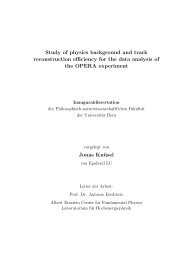Experiment Proposal - opera - Infn
Experiment Proposal - opera - Infn
Experiment Proposal - opera - Infn
Create successful ePaper yourself
Turn your PDF publications into a flip-book with our unique Google optimized e-Paper software.
Table 29: 90% CL limits on ∆m 2 defining the OPERA allowed region for full mixing. In the three<br />
columns we assume to observe a number of events corresponding to the best fit and to the 90% CL limits<br />
given bt Super-Kamiokande.<br />
True value 1.5 × 10 −3 eV 2 3.2 × 10 −3 eV 2 5.0 × 10 −3 eV 2<br />
Upper limit 2.1 × 10 −3 eV 2 3.8 × 10 −3 eV 2 5.6 × 10 −3 eV 2<br />
Lower limit 0.8 × 10 −3 eV 2 2.6 × 10 −3 eV 2 4.3 × 10 −3 eV 2<br />
(Upper-Lower)/True 41% 19% 12%<br />
detection of ν τ appearance. However, we point out that additional constraints can be extracted from the<br />
reconstruction of the event topology and that, therefore, additional decay channels may be included in<br />
the analysis, such as muonic and hadronic τ decays in the lead (short kinks) or a specific ρ search in the<br />
hadronic channel. The determination of the oscillation parameters may therefore be improved.<br />
7.7 Additional physics subjects<br />
7.7.1 Search for ν µ ↔ ν e oscillations<br />
Because of the very good electron identification, OPERA is also sensitive to ν µ ↔ ν e oscillations. Together<br />
with the ν µ ↔ ν τ appearance search this measurement allows to perform an analysis of neutrino<br />
oscillation with three-flavour mixing.<br />
A background source for the ν µ ↔ ν e search is the ∼ 1% ν e (¯ν e ) contamination of the ν µ beam.<br />
Another one is given by electrons from the Dalitz decay of neutral pions produced in ν µ NC interactions<br />
(π 0 → e + e − γ) and photon to electron conversions in the lead plates (π 0 → 2γ followed by γN →<br />
e + e − N). The latter contribution is reduced by selecting neutrino interactions with one identified electron<br />
(positron) of measured energy greater than a given threshold. The contamination from pions misidentified<br />
as electrons has to be included as well.<br />
The statistical error on the background estimate determines the sensitivity of the measurement of<br />
the oscillation parameters together with systematic errors due to the uncertainty on the ν e content of<br />
the beam and on the number of pseudo-prompt electrons produced by π 0 ’s.<br />
The calculation of the detection efficiency, of the background and of the sensitivity is in progress. An<br />
estimate of the sensitivity has been given in [6], showing the capability of detecting ν µ ↔ ν e oscillations.<br />
7.7.2 Oscillation search through NC/CC ratio measurement<br />
The expected performance of the detector target as a calorimeter for shower energy measurement and<br />
the presence of spectrometers for the identification and the momentum determination of muons allow a<br />
198




